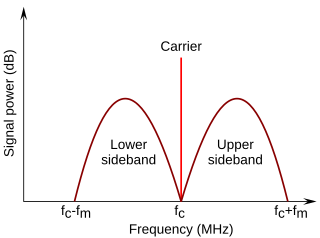
NTSC is the first American standard for analog television, published and adopted in 1941. In 1961, it was assigned the designation System M. It is also known as EIA standard 170.

In radio communications, a sideband is a band of frequencies higher than or lower than the carrier frequency, that are the result of the modulation process. The sidebands carry the information transmitted by the radio signal. The sidebands comprise all the spectral components of the modulated signal except the carrier. The signal components above the carrier frequency constitute the upper sideband (USB), and those below the carrier frequency constitute the lower sideband (LSB). All forms of modulation produce sidebands.

Vehicle audio is equipment installed in a car or other vehicle to provide in-car entertainment and information for the occupants. Until the 1950s, it consisted of a simple AM radio. Additions since then have included FM radio (1952), 8-track tape players, cassette players, record players, CD players, DVD players, Blu-ray players, navigation systems, Bluetooth telephone integration and audio streaming, and smartphone controllers like CarPlay and Android Auto. Once controlled from the dashboard with a few buttons, they can be controlled by steering wheel controls and voice commands.
Radio Data System (RDS) is a communications protocol standard for embedding small amounts of digital information in conventional FM radio broadcasts. RDS standardizes several types of information transmitted, including time, station identification and program information.
A broadcast range is the service area that a broadcast station or other transmission covers via radio waves. It is generally the area in which a station's signal strength is sufficient for most receivers to decode it. However, this also depends on interference from other stations.

A radiotelephone, abbreviated RT, is a radio communication system for conducting a conversation; radiotelephony means telephony by radio. It is in contrast to radiotelegraphy, which is radio transmission of telegrams (messages), or television, transmission of moving pictures and sound. The term is related to radio broadcasting, which transmit audio one way to listeners. Radiotelephony refers specifically to two-way radio systems for bidirectional person-to-person voice communication between separated users, such as CB radio or marine radio. In spite of the name, radiotelephony systems are not necessarily connected to or have anything to do with the telephone network, and in some radio services, including GMRS, interconnection is prohibited.
In-band on-channel (IBOC) is a hybrid method of transmitting digital radio and analog radio broadcast signals simultaneously on the same frequency. The name refers to the new digital signals being broadcast in the same AM or FM band (in-band), and associated with an existing radio channel (on-channel). By utilizing additional digital subcarriers or sidebands, digital information is multiplexed on existing signals, thus avoiding re-allocation of the broadcast bands.
A subcarrier is a sideband of a radio frequency carrier wave, which is modulated to send additional information. Examples include the provision of colour in a black and white television system or the provision of stereo in a monophonic radio broadcast. There is no physical difference between a carrier and a subcarrier; the "sub" implies that it has been derived from a carrier, which has been amplitude modulated by a steady signal and has a constant frequency relation to it.

The FM broadcast band is a range of radio frequencies used for FM broadcasting by radio stations. The range of frequencies used differs between different parts of the world. In Europe and Africa and in Australia and New Zealand, it spans from 87.5 to 108 megahertz (MHz) - also known as VHF Band II - while in the Americas it ranges from 88 to 108 MHz. The FM broadcast band in Japan uses 76 to 95 MHz, and in Brazil, 76 to 108 MHz. The International Radio and Television Organisation (OIRT) band in Eastern Europe is from 65.9 to 74.0 MHz, although these countries now primarily use the 87.5 to 108 MHz band, as in the case of Russia. Some other countries have already discontinued the OIRT band and have changed to the 87.5 to 108 MHz band.

DirectBand was a North American wireless datacast network owned and operated by Microsoft. It used FM radio broadcasts in over 100 cities to constantly transmit data to a variety of devices, including portable GPS devices, wristwatches and home weather stations.

WWV is a shortwave radio station, located near Fort Collins, Colorado. It has broadcast a continuous time signal since 1945, and implements United States government frequency standards, with transmitters operating on 2.5, 5, 10, 15, 20, and 25 MHz. WWV is operated by the U.S. National Institute of Standards and Technology (NIST), under the oversight of its Time and Frequency Division, which is part of NIST's Physical Measurement Laboratory based in Gaithersburg, Maryland.
Blaupunkt GmbH was a German manufacturer, producing mostly car-audio gear and other electronic equipment. Owned by Robert Bosch GmbH from 1933 until 1 March 2009, it was sold to Aurelius AG of Germany. It filed for bankruptcy in late 2015 with liquidation proceedings completed in early 2016. The brand, now managed by GIP Development SARL of Luxembourg, is licensed for use by various product groups worldwide.

Traffic Message Channel (TMC) is a technology for delivering traffic and travel information to motor vehicle drivers. It is digitally coded using the ALERT C or TPEG protocol into Radio Data System (RDS) carried via conventional FM radio broadcasts. It can also be transmitted on Digital Audio Broadcasting or satellite radio. TMC allows silent delivery of dynamic information suitable for reproduction or display in the user's language without interrupting audio broadcast services. Both public and commercial services are operational in many countries. When data is integrated directly into a navigation system, traffic information can be used in the system's route calculation.
Datacasting is the transmission of data over a wide area using radio waves. It typically refers to supplemental information sent by television stations alongside digital terrestrial television (DTT) signals. However, datacasting can also be applied to digital data signals carried on analog TV or radio broadcasts.

FM broadcasting is a method of radio broadcasting that uses frequency modulation (FM) of the radio broadcast carrier wave. Invented in 1933 by American engineer Edwin Armstrong, wide-band FM is used worldwide to transmit high-fidelity sound over broadcast radio. FM broadcasting offers higher fidelity—more accurate reproduction of the original program sound—than other broadcasting techniques, such as AM broadcasting. It is also less susceptible to common forms of interference, having less static and popping sounds than are often heard on AM. Therefore, FM is used for most broadcasts of music and general audio. FM radio stations use the very high frequency range of radio frequencies.
Zweikanalton or A2 Stereo, is an analog television sound transmission system used in Germany, Austria, Australia, Switzerland, Netherlands and some other countries that use or used CCIR systems. South Korea utilized a modified version of Zweikanalton for the NTSC analog television standard. It relies on two separate FM carriers.

Astra Digital Radio (ADR) was a system used by SES for digital radio transmissions on the early Astra satellites, using the audio subcarrier frequencies of analogue television channels. It was introduced in 1995. As of February 2008, there were still 51 stations transmitting in this format. ADR ceased on 30 April 2012 when analogue broadcasts on Astra 19.2°E ended.
FMeXtra is a deprecated in-band on-channel digital radio broadcasting technology created by Digital Radio Express. It was intended to allow a second all-digital signal to be simulcast with an existing analog FM radio station, offering a less noisy signal that would be particularly useful in urban environments where multipath distortion can seriously degrade analog FM transmissions. It can also support a second all-digital channel at the same frequency, allowing two channels to be broadcast by a single FM station.
In a conventional, analog two-way radio system, a standard radio has noise squelch or carrier squelch, which allows a radio to receive all transmissions. Selective calling is used to address a subset of all two-way radios on a single radio frequency channel. Where more than one user is on the same channel, selective calling can address a subset of all receivers or can direct a call to a single radio. Selective calling features fit into two major categories—individual calling and group calling. Individual calls generally have longer time-constants: it takes more air-time to call an individual radio unit than to call a large group of radios.
Data Radio Channel (DARC) is a high-rate (16 kbit/s) standard for encoding data in a subcarrier over FM radio broadcasts. It uses a frequency of 76 kHz, the fourth harmonic of the FM radio pilot tone.